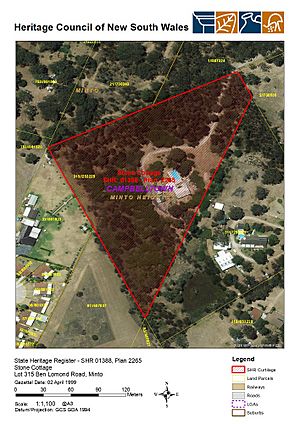Stone Cottage, Minto facts for kids
Quick facts for kids Stone Cottage |
|
|---|---|

Heritage boundaries
|
|
| Location | Lot 315 Ben Lomond Road, Minto, City of Campbelltown, New South Wales, Australia |
| Built | 1830 |
| Owner | Department of Planning and Infrastructure |
| Official name: Stone Cottage; "The Jug" site or former Vineyards | |
| Type | state heritage (built) |
| Designated | 2 April 1999 |
| Reference no. | 1388 |
| Type | Homestead Complex |
| Category | Farming and Grazing |
| Lua error in Module:Location_map at line 420: attempt to index field 'wikibase' (a nil value). | |
Stone Cottage is a very old house in Minto, Australia. It was built way back in 1830! This special cottage is important because it shows us what life was like in early Australia, especially how people used to farm the land. It's also known as The Jug site or former Vineyards. The New South Wales government helps look after it. Stone Cottage is officially listed on the New South Wales State Heritage Register, which means it's a protected historical site.
Contents
The Story of Stone Cottage
This cottage was likely used by farm workers. They worked for Dr William Redfern at his large farm called Campbellfield. Dr Redfern lived there from about 1818 to 1828. Later, his son, W. L. M. Redfern, was recorded as selling the property.
In 1949, a couple named Mr. and Mrs. Briggs bought the house. It had been empty for about ten years before they moved in. People who lived there later heard that the cottage was first used by a convict overseer (a person in charge of convicts) and several convicts. This might explain why one of the rooms could only be entered from outside, not from the other rooms inside the house.
What Stone Cottage Looks Like
Stone Cottage is made of sandstone and has three main rooms. Each room is about 4.6 meters (15 feet) long and 3.8 meters (12.5 feet) wide. The walls are very thick, about 0.3 meters (one foot) wide, and are painted on the outside.
There's a verandah at the front of the cottage. A wooden part was added to the back of the house in the 1950s. The outside walls were painted again in 1997.
How the Cottage Has Changed
When Mr. and Mrs. Briggs bought the house, they carefully fixed it up. They kept all the original doors and windows. They also kept the special double fireplace. They added new rooms to the back of the house and redesigned the garden. Inside, all the walls were painted white.
Current Condition
Stone Cottage has been looked after quite well. However, there is a large crack in the sandstone on the eastern wall, near the fuse box. There are also some cracks on the western wall and the front of the house. Overall, the cottage still looks much like it did originally, even with the small changes made over the years.
Why Stone Cottage is Important
Stone Cottage is a very important historical building from around the 1830s. It helps us understand how convict labour was used to develop farms in the Macarthur Region of New South Wales. The cottage gives us a rare look into how convicts and their overseers worked together. They played a big part in growing food for the early colony.
Stone Cottage was added to the New South Wales State Heritage Register because it meets several important requirements:
- It shows us history: The cottage is a great example of an early building connected to farming and the use of convicts in the Macarthur area. It helps us see how convicts and their overseers helped provide food for the new colony.
- It's beautiful and well-made: Stone Cottage is a lovely example of a simple, old cottage from the colonial period. It shows the building style of that time.
- It connects to people and culture: The cottage is important because it was part of the system where convicts were used for work. It also has a link to the Redfern family, who were significant landowners. It helps us understand the relationships between convicts and their overseers.
- It can teach us more: The cottage can help researchers learn about old building methods from the colonial era. It's also a good example of a building used for convict labor and farm development.
- It's a rare find: Stone Cottage seems to be a rare example of a building connected to convict labor on a big farm. More study is needed to confirm just how rare it is.
- It's a good example of its kind: The cottage is an excellent example of a building that shows how convict labor was used on a major farm in the region.

